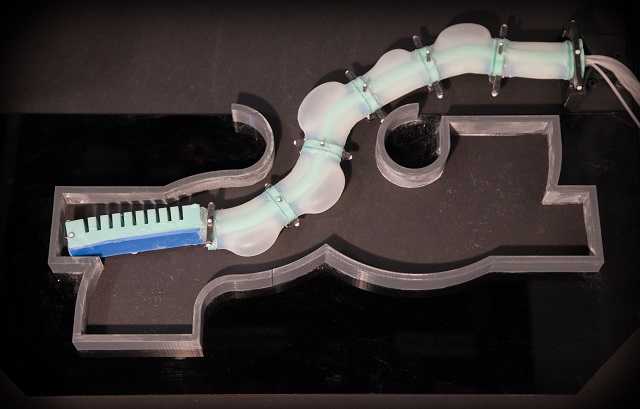 The CSAIL team's rubber robotic arm moves using pressurized air that causes it to change shape like a balloon. Photo: Jason Dorfman, CSAIL
The CSAIL team's rubber robotic arm moves using pressurized air that causes it to change shape like a balloon. Photo: Jason Dorfman, CSAIL
Scientists from the Computer Science and Artificial Intelligence Lab (CSAIL) of MIT have designed a soft robotic arm capable of slithering through pipe-like structures similar to a snake. The arm design is similar to that of octopus tentacles.
3D-printed molds were used to fabricate the arm, which is the latest project done by the CSAIL research group headed by Director Daniela Rus. The group has been working on soft robots that are more effective, resilient, and safe for specific tasks when compared to their rigid counterparts. Soft robots can also fit into tight spots and move in a more agile manner.
Andrew Marchese, a doctoral candidate, led the research and Robert Katzschmann, a PhD student, and Daniela Rus were part of the research. Complicated algorithms were developed to determine the body curvature required for the robot to make different movements.
There were several challenges to overcome, for example, determining the particular set of curved arcs required to get the robot to a specific point in space, especially in a confined area such as a pipe.
CSAIL Robotic Arm Slithers Like A Snake Through Pipes
CSAIL robotic arm slithers like a snake through pipes. Video: CSAIL
The softness of the robotic arm prevented the attachment of a typical motor shaft. Instead, expandable, hollow channels were designed on either side of the arm which, when filled with air, applied strain on the silicone. This caused changes in shape similar to a balloon, enabling bending of the arm to one side.
The 100% silicone rubber arm is another distinct feature that challenged the researchers to develop appropriate programming to enable the robot’s highly soft body to adapt easily to moving in human environments.
The arm has the potential to be used in handling of delicate specimens, assisting in certain types of surgery and in precisely tuned tasks in factories. The future version of the robotic arm will have a finger-gripper for picking and placing objects.